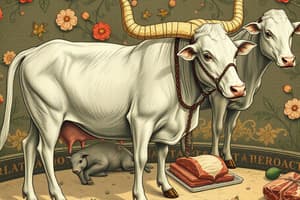Podcast
Questions and Answers
What was the average temperature for animals with black muzzle color?
What was the average temperature for animals with black muzzle color?
- 40.0°C (correct)
- 39.4°C
- 39.3°C
- 39.6°C
What percentage of animals were classified as pied based on their muzzle color?
What percentage of animals were classified as pied based on their muzzle color?
- 15% (correct)
- 82%
- 3%
- 39.3%
Did the means differ between animals with different muzzle colors?
Did the means differ between animals with different muzzle colors?
- No, they were all the same (correct)
- Not mentioned in the text
- Yes, significantly
- Yes, but only between white and pied
What was the difference in temperature between animals classified as white and those classified as pied?
What was the difference in temperature between animals classified as white and those classified as pied?
Which color category had the highest percentage of animals according to their muzzle color?
Which color category had the highest percentage of animals according to their muzzle color?
Was there a significant temperature difference observed between animals classified as black and those classified as pied?
Was there a significant temperature difference observed between animals classified as black and those classified as pied?
What was the area of the animal from which hair samples were collected?
What was the area of the animal from which hair samples were collected?
Which of the following was NOT a color classification for the animals' coats?
Which of the following was NOT a color classification for the animals' coats?
Which of the following was a classification for the animals' muzzle color?
Which of the following was a classification for the animals' muzzle color?
What tool was used to measure the hair samples?
What tool was used to measure the hair samples?
Where were the blood samples collected from in the animals?
Where were the blood samples collected from in the animals?
Which of the following was NOT a parameter analyzed in the hemogram analysis?
Which of the following was NOT a parameter analyzed in the hemogram analysis?
What did the results of the study mentioned show about the influence of hair length, coat color, and muzzle color on RT and LS traits?
What did the results of the study mentioned show about the influence of hair length, coat color, and muzzle color on RT and LS traits?
Why were RT and LS not influenced by hair and skin traits evaluated?
Why were RT and LS not influenced by hair and skin traits evaluated?
What did Nicolau et al. observe regarding the correlation between RT and hair length, hair, or skin colors in Caracu cattle?
What did Nicolau et al. observe regarding the correlation between RT and hair length, hair, or skin colors in Caracu cattle?
The text mentions that adaptation to hot environments leads to resistance to heat stress. What factor is highlighted as being more important than coat type in this adaptation?
The text mentions that adaptation to hot environments leads to resistance to heat stress. What factor is highlighted as being more important than coat type in this adaptation?
Based on the information provided, what is suggested as a reason for why RT and LS were not influenced by hair and skin traits?
Based on the information provided, what is suggested as a reason for why RT and LS were not influenced by hair and skin traits?
What conclusion can be drawn about the importance of hair and skin traits for evaluating heat stress in Caracu cattle based on the study results?
What conclusion can be drawn about the importance of hair and skin traits for evaluating heat stress in Caracu cattle based on the study results?
Flashcards are hidden until you start studying




